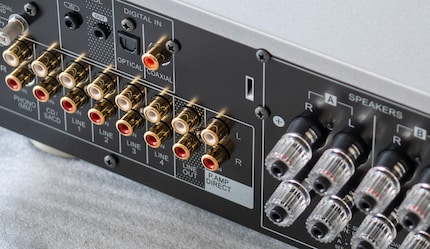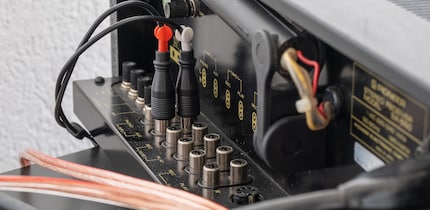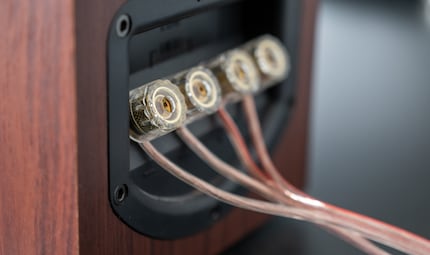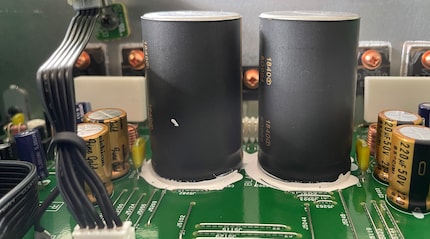
Background information
The revival of the Pioneer SX-550
by David Lee

Classic stereo amps still exist! You know – the ones that don’t try to be anything other than an amplifier. The Pioneer A-40AE can replace your old amp, even if the vintage feeling is lost.
I recently dug out an old Pioneer amplifier and gave it a facelift. Why? Mainly because I’m a sucker for the vintage look of older devices. But I ended up quite liking the sound, too.
I found myself wondering: is there anything similar on the market today? Aficionados of old hi-fi systems agree: no, there isn’t. That’s why you should take care of your old equipment.
You really won’t find an amplifier with this design and these features today. It also wouldn’t make sense if you did. After all, you’d be passing on all the progress made in hi-fi audio over the last 40 years. What you’d get in return are functions that are – by today’s standards – useless. Old amplifiers are actually receivers; they have an integrated radio. Therefore, half of the front panel is occupied by an analogue frequency scale. The frequencies for medium wave broadcasting are already obsolete today and, soon enough, VHF will also be discontinued.
On the other hand, desirable elements include the classic, silver design, high-quality workmanship, durable components and beautiful sound. And preferably no voguish bells and whistles.
The Pioneer A-40AE could be the amp I’m looking for: same brand, same colour, roughly the same dimensions and, given the 42 years between the two models, surprisingly similar features.
The similarities include:
I’ve already mentioned the most obvious difference, namely that the Pioneer A-40AE isn’t a receiver and therefore has no integrated radio. It’s also not as old-fashioned as it seems at first glance. While it doesn’t offer integrated network functions or USB ports, it’s definitely adapted to the digital age, as the differences show.
| Pioneer SX-550 | Pioneer A-40AE | |
|---|---|---|
| Remote control | No | Yes |
| Line in | 3 (2× Tape, 1× Aux) | 4 |
| Line out | 2 (Tape) | 1 |
| CD slot | No | Yes |
| Digital optical connection | No | Yes |
| Digital coaxial connection | No | Yes |
| Preamp connection | No | Yes |
| Mono switch | Yes | No |
| Mikrofon jack | Yes | No |
The microphone jack on the Pioneer SX-550 isn’t particularly useful, given it can’t be mixed with other sources. And – while I’m on the complaining train – when you plug in a pair of headphones, the speakers don’t automatically turn off. Welcome to 1980.
At 8.2 kilogrammes, the Pioneer A-40AE feels like a proper amp. It looks well made, and I like the design. The rear looks nicer than on the old Pioneer SX-550, but the ports are less accessible from the back than from the top.


The control knobs feel cheap – light and hollow. The ones on the old device feel heavier and very sturdy, even though they’re also partly made of plastic. Still, the knobs on the A-40AE turn smoothly, have no slack and are neither too loose nor too tight. Only the input dial feels too loose for my taste.
The labels are small, but very legible.
First, I play around with the sound settings. The amplifier has a direct circuit which transmits the bass and treble. This shorter path is supposed to deliver better sound quality. I only hear a difference when there’s no music playing. In Direct Mode, the speaker only starts audibly hissing shortly before reaching maximum volume. With Direct Mode off, the hissing is already audible at about 60 per cent volume – and if you turn up the treble, the effect intensifies.

Like on the older model, there’s also a «loudness» switch. You can use it to boost the bass and treble to get powerful sound even at low volume. It sounds significantly different to simply tweaking the bass and treble yourself. I like it very much. The downside is that with «Loudness» enabled, a hissing noise is audible even at low volume – though fortunately only when no music is playing.
Next, I connect my stereo speakers to both the old and new amplifier simultaneously. This is made possible by my speakers’ dual inputs. Update: That probably wasn’t the best idea. It’s better to plug in only one at a time, even if this means there’s a pause between comparing the two amps.

The old Pioneer SX-550 only hisses very, very quietly in direct comparison with the A-40AE, whether «Loudness» is on or off. The noise doesn’t increase with the volume either. Only turning up the treble increases the hissing a bit. One-nil for the old geezer.
When it comes to sound, the comparison immediately paints a clear picture: the old amplifier lacks treble. To get to the same level as the new one in neutral position, it has to be turned up to the maximum. Whether this is a sign of age or simply the sound engineering on the Pioneer SX-550, I can’t say. It doesn’t sound dull enough for me to assume it’s legitimately defective. But a bit more leeway with the treble would be nice. Most importantly, the treble certainly shouldn’t be diminished any more in the future.
Update: after connecting the boxes individually and listening to them again, I can no longer make out a lack of treble. The old Pioneer sounds great.
Treble aside, the two amps still sound different, though I can’t say which is better. The new one sounds harder and drier and possibly more precise. I like the stereo sound better on the old one, though I really can’t say why.
What’s clear is that the Pioneer SX-550 can get significantly louder, despite the fact that the technical data shows a significantly lower power output. However, I didn’t turn the devices up to max power, so it’s possible that the result at max volume would be different.
The fascinating thing about the Pioneer SX-550 is that it still runs flawlessly at over 40 years of age. I wonder if the new one will make it that far. Who knows?
A look at the insides at least shows that no as-cheap-as-possible capacitors were used. The two large main capacitors were created in collaboration with Elna, a German component manufacturer with a good reputation. Apart from that, it contains components from the Japanese manufacturers Panasonic and Nichicon.

The Pioneer A-40AE has no features that are bound to quickly become outdated. On my 2012 amplifier, several things were outdated within just a few years: the Bluetooth version, the slow USB port, and the Spotify integration which stopped working at some point. The Pioneer A-40AE doesn’t have such modern frills and furbelows built in to begin with. That means you won’t find yourself waiting in vain for a firmware update, either. This certainly speaks in favour of a long service life.
The Pioneer A-40AE is a worthy replacement for veteran amps whose time for retirement has come. There’s nothing to complain about in terms of sound and handling – except for the hissing when «Loudness» is on. The new device lacks the 70s and 80s charm, but it’s adapted to today’s time in terms of its tech and is still a classic hi-fi amplifier. It’s impossible to say whether it’ll prove to be just as durable, but its build suggests that it could be.
My interest in IT and writing landed me in tech journalism early on (2000). I want to know how we can use technology without being used. Outside of the office, I’m a keen musician who makes up for lacking talent with excessive enthusiasm.